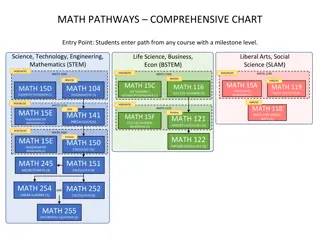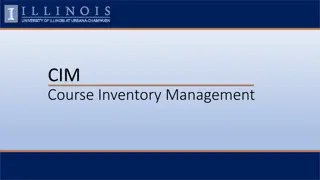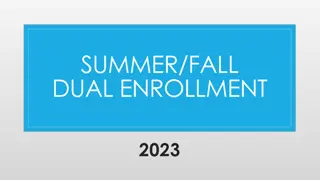Applying QM Standards to Enhance Face-to-Face Courses
Explore how Quality Matters (QM) standards can be applied to in-person courses for a more dynamic and purposeful classroom. Learn how to integrate QM principles into syllabus design, activities, lectures, and assessments. Design effective learning objectives and outlines for face-to-face sessions.
Download Presentation

Please find below an Image/Link to download the presentation.
The content on the website is provided AS IS for your information and personal use only. It may not be sold, licensed, or shared on other websites without obtaining consent from the author. Download presentation by click this link. If you encounter any issues during the download, it is possible that the publisher has removed the file from their server.
E N D
Presentation Transcript
Applying QM to a Face-to-Face Course Blending, Flipping, Extending: QM Beyond the Online Stacey S Cofield, PhD Associate Professor, Department of Biostatistics
The Course Today QM standards can be effectively applied to an in person, traditional, lecture-based course to achieve a more dynamic and purposeful class room. This session will look at how course competencies can be supported using QM standards, including: The syllabus Independent and group activities Lectures Assessments: homework, exams, and projects
Objectives Today Apply QM standards to a face-to-face class (f2f) Categorize learning activities to a module-level, course-level, or competency (degree) level objective Design a three-level outline for a f2f session incorporating think do explain activities
How will we meet the Objectives? Who am I? Review the QM Rubrics What Can Go Online? Applying the Rubrics Building Active Learning from the Beginning A Dynamic Classroom
Who Am I? Associate Professor Research Methods & Clinical Trials Graduate Program Committee Online Courses Committee Clinical Research Areas: Multiple Sclerosis Rheumatoid Arthritis Statistical Research Areas: Longitudinal Modeling Missing Data Approaches Patient Reported Outcomes Graduate & Undergraduate Online Teaching: BST 611 & 612: Applied Introductory Biostatistics (no math requirement) 2008-2012: f2f with recorded lectures posted online 2013-2016: stand alone online content Multiple Blended Courses
QM For each slide the QM rubric will appear in the upper right corner QM Rubrics 1. Course Overview and Introduction 3.1 2. Learning Objectives: 2.1 & 2.2 Learning Objectives 3. Assessment and Measurement: 3.1 Assessments 5.1 6.1 4. Resources and Materials: 4.1 Instructional Materials Key 5. Learner Engagement: 5.1 Course Activities Elements 6. Course Technology: 6.1 Course Tools 2.1 & 2.2 7. Learner Support 4.1 8. Accessibility
QM 1 Your Course Overview and Introduction Following QM for Rubric 1 frees up time in class A lot of the first f2f lecture can now live online: Set up a syllabus quiz Online introduction discussion forum Clarity in course expectations
QM 1 Communication is key Policies, due dates, & grades should be clear up front Post online If it impacts student performance, post or email AND say in f2f
QM 2 Getting Started on QM 2 It will be impossible for students to understand the goals of the course if you don t understand them start to finish Get a big picture idea of what you want out of the course & the f2f interactions What major topics will be covered? What learning materials will be presented? What technologies and media will be needed QM 6?
QM 2 2.1 & 2.1 Learning Objectives These are often lost on students & can be broad End the course with a review The end of the course would be the slideshow of the trip End by asking them what they did gain Start the course with an overview Think of this as having your reservations for a trip Start by asking students what they hope to gain from the course
QM 2 2.1 & 2.1 Learning Objectives Degree or Course Objectives may be mandated They may not be written as student-centered or active objectives What you can do is look at each objective and then align your course goals with each objective It will help if you can also align the lecture objectives
QM 2 Learning Objective Alignment Degree Objective: Broad Concept Course Objective: Specific Understanding Module Objective: Practicing Application
QM 2 Learning Objective Alignment Activity #1 PUH 350 Beating the Odds: Statistical Modeling & Disease Prediction Activity 1 You each have 6 objectives: 2 degree, 2 course, 2 module See if you can align them in the diagram on your handout#1 Degree Objective: Broad Concept Course Objective: Specific Understanding Module Objective: Practicing Application
Objectives to Align on Handout # 1 a. Critique published research manuscripts b. Understand historical milestones in public health and how they influence current practice c. Complete the 11-point paper checklist for the assigned research paper d. Communicate public health approaches, messages, and findings effectively both orally and in writing e. Complete and ANOVA (linear model) using your statistical software and the 10-steps of analyzing data outline f. Interpret, explain, and write results of linear models analysis
QM 2 Learning Objective Alignment Activity #1 Degree Objective: Broad Concept b Degree Objective: Broad Concept d Course Objective: Specific Understanding a Course Objective: Specific Understanding f Module Objective: Practicing Application c Module Objective: Practicing Application e
QM 3 Assessments Once the degree objectives are aligned with course and module objectives, it is time to think about the course assessments Each assessment should be supported by the practicing application for the module objective Start simple and build to more complex assessments
QM 3 Assessments Simple assessments may include multiple choice, true- false, fill-in-the-blank, and matching type activities OR They can be self-assessments, learning checks, grade- free activities for practice can be online Use rubrics! We are forced to do so online because you can t defend your grading decisions to every single student very easily But if you have them for f2f you can use class time for more active learning or tutorials following assessments
QM 3 10% of what we read What Type of Assessments? 20% of what we hear 30% of what we see 50% of what we hear & see 70% of what we discuss with others 80% of what we experience with others 90% of what we teach to others From William Glasser
QM 3 What Type of Assessments? Think Plan Write Summarize Think Plan Do Start with an online activity Move the concept to f2f small group work Escalate to a large group discussion Address similar problem in a homework or exam Make thinking visible ~Vygotsky
QM 3 Assessments Activity # 2 Work in Pairs Each pair has a set of 6 post-it notes each with a different assessment for critiquing published research Put the post-its in the correct order on the boards starting with the first assessment on board #1
QM 3 6 Assessments Activity #2 Summarize the whole online discussion (homework, graded) Critique a classmate paragraph using rubric (graded for completion) Watch a video & complete learning checks (graded for completion) Post & reply to 3 classmates on the discussion board (graded) Write a paragraph taking pro & con position on one discussion point (submitted to professor for grade) Read published manuscript and complete the discussion check list (graded for completion)
QM 3 Assessments Activity #2 2. Read published manuscript and complete the discussion check list 3. Post & reply to 3 classmates on the discussion board (graded) 1. Watch a video & complete learning checks (graded for completion) (graded for completion) 4. Write a paragraph taking pro & con position on one discussion point (graded) 5. Critique a classmate paragraph using rubric 6. Summarize the entire discussion (paper or exam) (graded for completion)
QM 4 Instructional Materials A variety of materials allows different learners to achieve highest learning level Compiling the materials should go hand-in-hand with the types of assessments that are included You wouldn t want students to only read speeches for a course on giving speeches Having students watch videos would be more effective
QM 4 Instructional Materials In online courses, materials are often presented in a variety of ways to support the learning objectives: A video to watch Supporting or foundational materials to read Learning checks within the online materials ( Graded activities escalate ( grade-free activity homework exam QM 3) QM 3):
QM 4 Instructional Materials Escalate the active learning in materials: 1. Read about how to outline a speech (learning checks) 2. Watch a speech, create outline from the video (pass/fail) 3. Create own outline (graded) 4. Record one section of speech for review by class member or teacher (pass/fail) 5. Give full speech (graded)
QM 4 Instructional Materials The same things can be used effectively in f2f classes: Post readings or videos before class time Have small activities online prior to class Reserve class time for active learning The online system allows for reinforcement of materials with review videos Do not need to spend valuable f2f time in review
QM 5 Learner Engagement Each activity should promote some kind of learning interaction: Student to content: reading / watching Student to instructor: lecture / discussion Student to student: group work / discussion / peer review
QM 5 10% of what we read What Type of Activities? 20% of what we hear 30% of what we see 50% of what we hear & see 70% of what we discuss with others 80% of what we experience with others 90% of what we teach to others From William Glasser
QM 5 Outline for Course Activity #3 Using Handout #3, craft an outline of a Think Plan Do for a single course module There are examples on the handout but you may also use your own course example
QM 5 Outline for Course Activity #3 Let s share some examples
QM 6 Technology for the Assist A small amount of online time can reduce in person office hours Publish a digest of weekly Q&A emails or sessions Set up problem solving forums where students can peer-to-peer mentor with supervision everyone can see or read everything Augment f2f time with videos or tutorials online, can open up the classroom time for discussion
QM 7 & 8 Learner Support & Accessibility Again this is where QM can be used in the online delivery system to support your f2f goals Access to tutorials or other websites Direct links to school supports Even if you plan on largely lecture based, recording them and/or transcripting them is QM 4, 7 & 8!
Revisit Objectives for Today How was objective addressed? Activity Type Objective for Today Review of Rubrics Lecture Apply QM standards to a face-to-face class What Can Go Online? Lecture Applying QM Rubrics Activity #1 Categorize learning activities to a module- level, course-level, or competency (degree) level objective Overview of Assessment Types Lecture Alignment of Assessments Activity #2 Types of Instructional Materials Lecture Design a three-level outline for a f2f session incorporating think, do, and explain activities Types of Learner Engagement Lecture Outline Think Plan Do Activity #3
Thank You! SCofield@uab.edu























